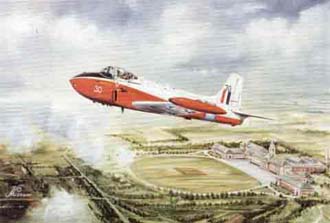History
Pakistan Air ForceINFANCY TO INDEPENDENCE (1933-1950)
When Karachi, Pakistan’s coastal mega city of over ten million was a tidy small town of 250, 000 in 1933, the British colonial government of India established the subcontinent’s first air force station near Drigh Road, now called Shara-e-Faisal Air Force Base. In 1934, this element of the Indian Air Force was extended to the north and the first air operations were launched in the North West Frontier Province to keep peace in the border areas along the Hindu Kush mountains. As World War II began in Europe reconnaissance aircraft, operating from a string of coastal air bases including Drigh Road, patrolled the Arabian Sea, the Indian Ocean and the Bay of Bengal. Then came the big test for the fledgling air force in India: providing air support to the British-led land and naval forces attempting to roll back the Japanese military expansion into the subcontinent. The IAF of that time, manned mostly by British personnel but also some Indian nationals including a handful of Muslim pilots, engineers and ground crews, was hardly a decade old when the war ended. This IAF’s outstanding contribution to the defeat of the Japanese invasion was greatly praised and in a gesture of the colonial times, the prefix Royal was added to its name, which became the RIAF.
MAY 1940
The end of World War II left Britain too weak to resist any further the long standing demand by the South Asian people for independence. Two sovereign states of Pakistan and India came into existence on August 14 and 15, 1947. in the distribution of resources, the lion’s share of military assets went to India and owing to India’s hostility attending the Muslim nation’s birth on the subcontinent, the Pakistan’s Army, Navy and Air Force were denied even the officially agreed small portions of weapons and equipment allocated by the departing British as the legitimate share of Pakistan. The RPAF got just 16 fighter aircraft at its foundation.
MIANWALI TO RISAPLUR-16 SEPTEMBER 1947
Within three weeks of independence, India illegally began airlifting troops into the still-uncommitted Muslim-majority state of Kashmir, and coerced its Hindu Maharaja fraudulently to accede to India in October 1947. This sparked off the first war between Pakistan and India and a spontaneous revolt by the Kashmiri people. The conflict demanded from Pakistan’s young air arm around the clock effort to airlift and airdrop badly needed supplies to the Pakistani troops, who eventually halted further advance of the Indian aggressors. In the narrow valleys of Kashmir, the stirring tale of Flying Officer Mukhtar Dogar defiantly scissoring his lumbering Dakota with pursuing JAF Tempests defined the fighting doctrine of the PAF — defend the fatherland with what you have and learn to fight outnumbered. In January 1948, the Indian Prime Minister, Jawaharlal Nehru, decided to have the dispute taken before the United Nations and a ceasefire agreement ended the war with the Kashmir territory under the divided control of both countries. Pakistan, confident of its strong legal and moral stand, readily agreed to have the injustice resolved through the world body. Fifty five years later, India was still using circular arguments to dishonor the pledge Nehru had made (broadcast by All India Radio on November 2, 1947) to the Indians and the Kashmiris — as well as to the UN member states — that the Kashmiri people will be given the right of self-determination through a UN-supervised plebiscite.
PROPELLERS TO THE JET AGE (1951- 1960)
In June 1951 the PAF entered the jet age with the Super marine Attacker fighter equipping the first jet squadron of the growing air force. Until the mid-1950s, the mainstay of the PAF’s fighter force continued to be the nearly one hundred Hawker Furies and a dwindling number of Tempests. There were new developments everywhere. New air bases were being established, the first air defence radar was installed, and the PAF was rapidly setting up its own advanced flying and technical training institutions. New generations of post independence youth were gaining skills and confidence under their Pakistani squadron and wing leaders. In 1955, Pakistan’s 4-decade association with the United States began in the Cold War against the Communist Bloc states led by the Soviet Union. This alliance transformed the PAF, with new technology jet fighters, bombers, trainers, transport aircraft and helicopters. The old fighter squadrons were gradually re-equipped with jet aircraft and many new ones were established.
ATTACKERS – ARRIVED IN AUGUST 51
Under its first Pakistani Commander-in-Chief, this modernization was extended to the PAF’s organization and consolidation into a purposefully designed force that could meet the new challenges to national security. A pervasive quest for professionalism began in all air and ground units and gradually replaced the World War II styles of command and leadership. In their foreign training courses the PAF pilots were now matching their combat skills with those of the world’s best air forces and achieving ever higher munitions delivery scores. In 1959 an F-86 pilot had already shot down a high-flying Indian reconnaissance Canberra bomber intruding into Pakistan territory and an year earlier a formation aerobatic team of sixteen Sabres had set a world record. The engineering, logistic and administrative officers were at the same time leading the PAF technicians into delivering unprecedented serviceability rates and efficient management of all resources. Derived from the national military objectives, the PAP’s leadership had clearly visualized and laid down the operational doctrine for the nation’s air arm and all its personnel were being trained and judged against the highest adoptable professional standards.
PERFORMED A LOOP DUSRING AN AIR DISPLAY AT MASRROR AIR BASE
WARS IN THE MACH 1 ERA (1961-1970)
The PAF grew to full maturity during the first half of this decade just as it was also turning into virtually an all-jet air force. Pakistan was now a member of the CENTO and SEATO defence treaties and its air force had repeatedly tested itself in combat exercises and other skills in flying and maintaining all the new aircraft, weapons, radars and communications gear, as well as the complexities of air wars in the supersonic age.
In May 1961, the first Mach 1 (1,500 mph) fighter, the F-104, entered the PAF inventory, matching the threat from the India’s Soviet-supplied Mig-21s. The challenge of high speed attack had by now become a routinely practised skill on the subcontinent. A border skirmish in the Rann of Kutch between Pakistan and India in April 1965 ended quickly but within months the mutual hostility escalated into a full scale war that began in the disputed territory of Kashmir. The PAF struck hard its rival force and kept it reeling under tactics of shock and unpredictability. Many victories came to PAF pilots in the war.
1105 HOURS, 3 SEPTEMBER 1965 – RASPUR AIRFIELD
The most notable among these were — Rafiqui’s heroic first and last missions as a combat leader, in which he and his wingmen shot down 9 enemy fighters; Alam’s downing of 5 lAF fighters in a single sortie; Haider’s Sabres wiping out of the Mig-21 force at Pathankot, destroying altogether 14 aircraft and the brilliant strike led by Shabbir, catching asleep the bomber base near Calcutta, during which it destroyed almost an entire Canberra squadron as well as some Hunter fighters.
6 SEPTEMBER 1965
1705 HOURS, 6 SEPTEMBER 1965
7 SEPTEMBER 1965
Equally significant was the contribution by the PAF’s B-57 bomber force that throughout the war wreaked nightly destruction and disruption at the deeper enemy airfields. The PAF’s decisive contribution to the land war came from the F-86 air support force that paralyzed the Indian Army formations trying to penetrate into Kashmir, Sialkot, Lahore and Kasur. Performing up to the high standards set for it during the preceding eight years, the outnumbered PAF emerged triumphant over a four times larger force in this war; its air defence controllers, engineers, logisticians and technical hands just as much the heroes as its pilots.
B-57S OVER AMBALA AIR BASE
2055 HOURS – 20 SEPTEMBER 1965
HERCULES BOMBER
21 SEPTEMBER 1965
TRAUMA AND RECONSTRUCTION (1971-1980)
The people of Pakistan, including many East and West Pakistani airmen serving in the PAF, went through an agonizing experience in 1970-71, when they watched their egocentric politicians refusing to yield power to a party that had won through fair elections and thus destroying the comradeship that had taken root during the preceding 23 years among the civilians, soldiers, sailors and airmen of the two wings.
The consequent polarization between the two wings of Pakistan was fully exploited by India and, emboldened by the Soviet Union through a treaty; it began preparations from early 1971 to invade East Pakistan. The third war between the South Asian foes began when the Indian Army crossed into East Pakistan and from the encircling air bases ten squadrons of the IAF challenged the PAF’s only squadron — No 14 — located at Dhaka. The Tail Choppers of 1965 rose heroically to meet the aggressors, and before their squadron ew as grounded by a bombed out runway, they and their ack ack gunners had destroyed 23 IAF aircraft. Pakistan’s retaliation from the west was spearheaded by the PAF’s Mirages, B-57s, Sabres, F-6s and a handful of F-104s.
3 DECEMBER 1971 – 8.PM
The initial phase of war in the west was fast and furious while the PAF waited for the Army’s call to begin its carefully timed air campaign in support of Pakistan’s – land offensive. The IAF, determined not to repeat its timid performance of 1965, also began a concentrated but ultimately unsuccessful campaign against the PAF bases in an attempt to render them ineffectual. Most of the aerial combat between the rival air forces occurred during this abortive bid by the IAF to wrest the control of the air.
1032 Hours, 4 December 1971
1045 Hours, 4 December 1971-Near Vhakwal Town
1145 HOurs, 4 December 1971
1445 HOurs, 4 December 1971
The PAF had made full use of the ten-month warning of India’s aggression and met confidently its adversary in the air while also keeping the IAF air bases under pressure with day and night attacks. Deploying in war for the first time were the Mirage and the F-6 fighters, both drawing first blood: the Mirage pilots destroyed 10 and damaged 3 enemy fighters without loss and the F-6 pilots destroyed 8 and damaged 2, losing only one F-6. At war’s end the PAF and its ack ack units had destroyed 130 enemy aircraft in the two theatres of war. Meanwhile Dhaka fell to India’s overwhelming military power and its army and air force immediately began to transfer their units to reinforce those already fighting against West Pakistan. The land offensive from the west was held up for too long while the world powers intervened to bring about a ceasefire through the United Nations.
1230 HOurs, 5 December 1971
2244 Hours, 5 December 1971
1200 HOurs, 7 December 1971-CHOR
SU-7 goes down over Shakargarh
7 December 1971
The trauma of the separation of East Pakistan and a preventable military catastrophe affected all Pakistanis deeply and lingered long afterward. A stoic recovery was however begun almost immediately in the western wing. Within a few years the PAF had reorganised and re-equipped with weapons and equipment better suited to the new threat environment on subcontinent, and the reality of living with an implacable opponent which seemed to have committed itself to a policy of constantly undermining Pakistan’s political, cultural and territorial independence.
FRONT LINE AIR FORCE (1981 Onwards)
When on the 1979 Christmas eve the Soviet Union sent in its army and air force to invade Afghanistan, Pakistan felt duty bound to become a sympathetic host to eventually 5 million refugees. For demanding Soviet withdrawal and providing shelter and unwavering support to the Afghans, Pakistan earned the animosity of Moscow and became a frontline state overnight. The United States led a coalition of solidarity with the Afghan Mujahideen and Pakistan. The lightly armed Afghans fought courageously a difficult, bloody war against the regular Soviet forces, supported by hundreds of gunship helicopters and jet fighter bombers. These aircraft frequently violated Pakistan’s territory on the pretext of hitting the Mujahideen sanctuaries, killing many Pakistani civilians each time. The PAF’s F-16s (available from 1983 onward) played a key role in bolstering the Mujahideen’s morale and keeping the Soviet air power from crushing the resistance. The F-16 pilots were not allowed hot pursuit into Afghanistan, but fought some classic air combats during which they scored 7 kills without any loss. The Geneva Accord of March 1988 and the Soviet withdrawal in May replaced external aggression with internal war in Afghanistan, since the pro-Soviet government still held power in Kabul. Despite Pakistan’s timely appeals little international support was pledged for taking the post-withdrawal Afghanistan through an era of peace and reconstruction. America’s engagement with Afghanistan ended abruptly with the Soviet withdrawal, and Pakistan’s role as a Cold war ally also ceased without ceremony as that war too ended in 1991.
F-16 DESTROYS AN INTRUDER
0520 HOURS, 17 MAY 1986 – PARACHINAR
F-16 VS SU-25
2010 HOURS 4 AUGUST 1988 – NEAR MIRANSHAH
The Mujahideen factions, no longer united, began a race for Kabul and an interim joint government set up in 1992 was mired in feuds and discord. Efforts by the Gulfs Muslim states and Pakistan to reunite the factions failed each time due to ethnically based mistrust and overconfidence among the veteran warlords. The power struggle led to a civil war (1992-1991) that left each warlord weakened and destroyed most of the traditional tolerance within Afghanistan’s multi-ethnic society. This vacuum was filled by the new, and initially popular, Taliban forces from Kandahar, which rapidly gained control over most of Afghanistan, capturing Kabul in late 1996. On 11 May 1998, India went overtly nuclear, perceiving an acquiescent world environment for its hegemonic ambitions. Two days later its prime minister threatened Islamabad with nuclear attack. Pakistan had long anticipated such behavior and the PAF had, since the late 1980s, already possessed a weaponised nuclear delivery capability, thanks to the monumental efforts, over several decades, by the country’s nuclear institutions. Waiting two weeks to confirm its belief that Pakistan’s restraint will not guarantee its security, Islamabad too carried out its tests at Chaghai on 28 and 30 May.
Meanwhile the Afghans continued to suffer. With unchallenged power but no modern education or experience of running a country. The Taliban government began to rule with harsh, unreasonable laws, based on questionable interpretation of religious tenets. The ‘Taliban leaders were soon left without any friends except Pakistan, and they began to spurn the well meant advice of even this last friend. The Taliban’s repeated refusals to oust known terrorists made them an enemy government, particularly after the shocking attacks on the Twin Towers and the Pentagon in September 2001. Pakistan strongly condemned these attacks and on its joining the international community’s war on terrorism, the PAF was assigned vital national security tasks. Sensing an opportunity, India immediately began an arrogant display of its military power, while Pakistan, by the compulsions of its geostrategic location, once again became a front line state.
OPERATION “SENTINEL”
The PAF took in its stride the 10-month war alert with India during 2002, when New Delhi unsuccessfully attempted a coercion strategy against Pakistan through its Operation “Parakram”. To counter the threat posed by India’s forward-deployed forces, all combat and support units, win, bases and commands of the PAF easily moved into Operation “Sentinel” of their own, assuming, holding and improving upon their assigned readiness states throughout the year. On 16 October 2002, India decided to back down. Among the PAF squadrons were some F-16s of No.11 Squadron, which regularly deployed through various main and forward operating bases during Operation “Sentinel.” Nestled in the deep, winding valleys of the Karakorams, Skardu FOB was one of the airfields that F-16s operated from. The painting shows a Falcon of 11 Squadron as it begins its take off roll on the Skardu runway, while a pair of A-5 fighters circles overhead.
NO.11 SQUADRON DEPLOYS TO THE KARAKORAMS
OPERATION “SENTINEL” JANUARY – OCTOBER 2002
JF-17 THUNDER MAKES PUBLIC DEBUT ON PAKISTAN DAY PARADE
ISLAMABAD – 0920 HOURS 23 MARCH 2007
After years of careful design conceptualisation and project planning between strongly bonded China and Pakistan, the first prototype of the JF-17 Thunder fighter flew in 2003. Making rapid progress under dedicated teams of pilots, engineers, technicians and support personnel from both countries, the JF-17 soon began to exceed its design expectations and finally emerged as a high-performance, agile multi-role fighter possessing state-of-the-art capabilities in ordnance arrays, avionics and strike reach that are comparable to the world’s frontline fighters of the new century. The President, General Pervez Musharraf performed the unveiling ceremony of the Thunder at PAC Kamra on 21 March 2007. ‘iWo days later, a pair of JF-17s made their first public appearance over lslamabad during the Pakistan Day Parade, reviewed by the President. The painting shows one of the two Thunders, painted in the striking colours of China and Pakistan, as its pilot, Wing Commander Ahsan, passes before the spectator stands during a rolling manoeuvre.
MOTORWAY OPERATIONS BY NO.15 SQUADRON
EXERCISE HIGHMARK 2010, SITE BB433 – 1100 HOURS, 2 APRIL 2010
Pakistan’s motorways have by design multiplied the PAF’s operational flexibility and options. During Exercise Highmark 2010’s surge phase, several types of the PAF’s combat and support aircraft are given missions that involve Operations from different locations on Pakistan’s network of motorways.
The assigned pilots take in their stride the relatively narrow width of their makeshift runways, the near proximity of towering trees and the telephone pole obstructions on either side during take of1 and landings. While rolling down the roads they have to get used to the absence of DMBs (Distance Marker Boards) and find, instead, eye catching signs telling them how many kilometres short they are of sizzling fast food and chilled beverages. But the pilots of this two-seat Mirage 5DD have other things on their minds. They must refuel and rearm quickly and get airborne again to make a Time on Target (TOT) given in their Tasking Order
THE PRIME MINISTER WITNESSES JF-17 THUNDER’S BOMBING PRECISION – EXERCISE HIGHMARK 2010
THAL FIRING RANGE – 1120 HOURS, 6 APRIL 2010
“PEACE CANNOT BE SECURED FROM A POSITION OF WEAKNESS. IT COMES ONLY THROUGH STRENGTH. OUR MISSION IS TO MAINTAIN PEACE WITH HONOUR IN THE REGION”
says Air Chief Marshal Rao Qamar Suleman in his introductory remarks at the PAF’s Fire Power Demonstration during Exercise Highmark 2010.
Just two months after the Prime Minister of Pakistan, Mr. Yousaf Raza Gilani, unveiled the first indigenously produced JF-17 Thunder at PAC, Kamra, No. 26 Squadron pilots feel honoured when the Air Chief asks the world’s first operational Thunder squadron to demonstrate its bombing accuracy to the Prime Minister and some cabinet members. Also present on the occasion are all the three Services Chiefs, the Chairman JCSC and Defence Attaches from all the Embassies in Islamabad.
The painting shows four JF-17s having just delivered two types of bombs with great precision. The Visitors’ Observation Post is visible through the haze in the upper left half of the frame. The leader and No. 2 drop two Mk. 82 (500 Ib) bombs each from their under-wing pylons. Following them are No. 3 and No. 4, who deliver one Mk. 84 (2,000 Ib) bomb each from their centreline pylons. A loud applause goes up in the Observation Post when Wing Commander Khalid Mehmood, the Squadron Commander, flying as No.4 (so that he could for safety reasons take the target closest to the guests), also joins his other three pilots in achieving a direct hit.
IZMIR AFB, TURKEY – 1430 HOURS 4 JUNE 2011
An air contingent from the PAF was sent to Izmir AFB, Turkey, in 2011 to join similar delegations from nearly fifty other nations for the Centenary Celebration s of the Turkish Air Force. The Pakistani delegation was led by the VCAS, Mr Marshal Tahir Rafique Butt, who was appointed the Chief of the Air Staff in March 2012. On the programme of festivities, one of the main events was a TAF air show at the Izmir air base, in which aircraft flown in from several friendly countries also participated. The PAF chose its newest fighter — JF-17 Thunder — to perform at this display. The occasion was unique as the show pilot was the squadron commander of the world’s first JF-17 squadron, No. 26, which had a long history of distinguished servicen the unit’s earlier combat aircraft, namely the F-86, the F-6 and the A-5C.
The agile Thunder in the hands of Wing Commander Khalid Mehmood, OC No. 26 Squadron, impressed the large number of spectators and his plane was locally nicknamed “Thunder from the East.” Artist Hussaini has chosen a downward view to include the ground display of parked historical aircraft of the TAF and many festively dressed celebrators, here seen on the lzmir taxiway.
FOREIGN MISSIONS
PAF heroes form a galaxy of dedicated men who have expanded their lives in the service of Pakistan Air Force, each leaving behind the best of himself, and adding yet another measure to the courage and honour poured into its foundations by those before him; that endless cavalcade of men who look back with swelling pride and say, ‘ I was in the Pakistan Air Force’
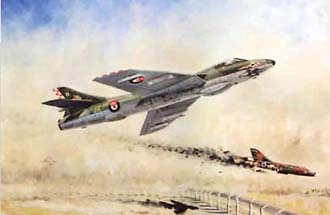
HUNTER KILLS A SUPER MYSTERE - 5TH JUN 1967
During an encounter over the Jordanian air base Mafrak, Flight Lieutenant Saiful Azam shot down an Israeli Super Mystere and damaged another.
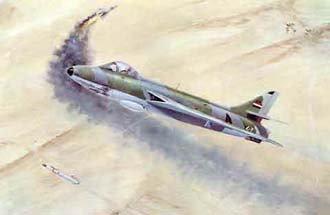
HUNTER DESTROYS AN ISRAELI MIRAGE - 7TH JUN, 1967
During his second encounter with Israeli aircraft, Flight Lieutenant Saiful Azam destroyed one Mirage and one Vatour bomber in Iraq.
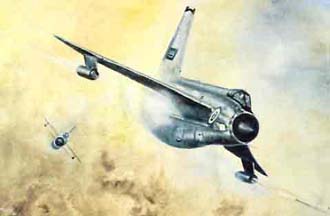
BATTLE OF SHAROORA - 1969, SAUDI ARABIA
During the 1969 South Yemen – Saudi conflict, many PAF men and officers from different branches based at Khamis took active part in the battle.
SAEED ACHIEVES A UNIQUE HONOUR - 26TH FEB, 1971
The painting shows a Jet Provost trainer of the British Royal Air Force – piloted by Pakistani Flight Cadet Saeed Ahmad – as it passes over the RAF College, Cranwell, from where Saeed would soon get his wings. On graduation day, he became the first Asian cadet pilot to win the coveted ‘Battle of Britain Aerobatics Trophy’ at the world’s oldest flying institution. By a rear coincidence, he received the trophy from another Pakistani, Air Marshal A Rahim Khan, C-in-C, PAF who had been requested to review the graduation parade. The Air Marshal was in England at the time on a goodwill visit, touring various RAF establishments.
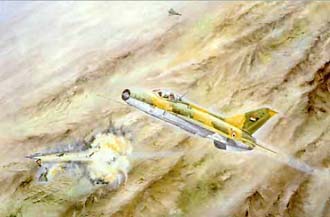
PAF PILOT DOWNS AN ISRAELI MIRAGE - 26TH APRIL, 1974
During an encounter over Golan Heights between a MIG-21 of the Syrain Air Force flown by Flight Lieutenant A. Sattar Alvi shot down one Israeli Mirage.
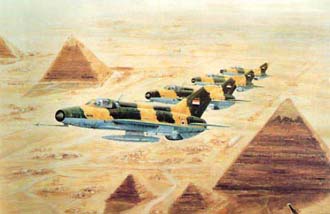
PAF DURING YOM KIPPUR WAR - EGYPT
During the Yom Kippur War, PAF pilots deployed at Inchas air base Egypt, participated in operational missions.

